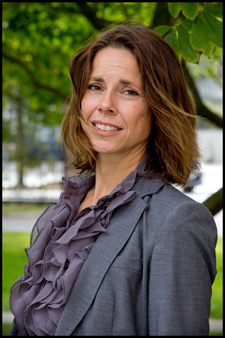Lise Arleth appointed professor of experimental biophysics
Lise Arleth has been appointed professor in the research group Neutron and X-ray Scattering at the Niels Bohr Institute at the University of Copenhagen.
Lise Arleth has been appointed professor in the research group Neutron and X-ray Scattering at the Niels Bohr Institute
Neutron and x-ray scattering is used to study the atomic structure of solids on a nanometer scale. Lise Arleth researches what biological molecules look like. In particular, she is interested in studying proteins in the cell membranes in order to understand what they look like, how they move and how they function in general. She uses the methods of condensed matter physics – especially x-ray and neutron scattering to study the structures and properties of biophysics.
Captured by physics
Becoming a physicist certainly was not her dream. In gymnasium, she was really good at math and physics, but she thought it was rather unpractical, so she certainly did not want to be a physicist.
“So I began studying at Roskilde University where I started with math and communication – and then I also took just a few physics courses on the side. The mathematics was exciting, but communication never really took. However, the physics took, so I dropped communication and chose more and more physics,” explains Lise Arleth, who received her MSc. from Roskilde University in ’95.
During her thesis, she spent half a year in Paris, where she worked with x-ray small-angle scattering and self-organising systems. Meanwhile, a researcher from Risø visited and he invited her to apply for a PhD position at Risø.
“Then I came to Risø to do a PhD in biophysics and especially small-angle scattering. It was really exciting, but it took a lot of years because I was at Australian National University for half a year and then a half a year at the Courant Institute at New York University and when I got home I had to kids,” explains Lise Arleth.
Catches sight of biophysics
She finished her PhD in 2001 and was pulled abroad again – this time it was to work for a year in a postdoctoral position at Los Alamos in New Mexico, USA. Here she began to work with more biological and pharmaceutical relevant systems, which she quickly became caught up in. Then she was back at Risø for a year, after which she was encouraged to apply for position as an assistant professor at the Agricultural University, where she began to build up her own research group in 2004.
“There was a wonderfully interdisciplinary environment at the Agricultural University, where I as a physicist worked with chemists, biologists, statisticians and also collaborated with companies like Novo Nordisk. In my group, we especially focused on proteins, how they self-organise in aqueous environments and how we could see this with x-rays and neutrons. This knowledge provides new insight into how medicine works,” she explains.
Champion of ESS
The experiments are conducted at major, international research facilities like ILL/ESRF in Grenoble, PSI in Switzerland, DESY in Hamburg and since 2001, Lise Arleth has been one of the local champions of ESS and MAX IV, which will be located here in the Øresund region in Lund, where construction is now full swing.
In 2012, Lise Arleth came to the Niels Bohr Institute, where she heads a research group in structural biophysics. The focus is still on the self-organisation that occurs in complex biological structures and how they can be studied with x-rays and neutrons. However, over the years, it has become possible to increase the complexity of the membrane proteins located in the cell membranes and their interaction with the membranes.
“My group is still entirely dependent on being able to work closely with, for example, biologists concerning the systems. We also still have a lot of contact with industry. One of the really positive new things about coming to the Niels Bohr Institute is the number of fantastically talented physics students that we have here. It is a great pleasure and also a great privilege to work with them, both as a director of physics studies and as a teacher and supervisor,” says Lise Arleth.

